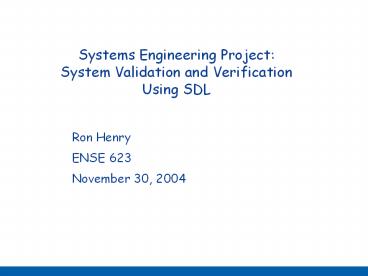Systems Engineering Project: System Validation and Verification Using SDL PowerPoint PPT Presentation
Title: Systems Engineering Project: System Validation and Verification Using SDL
1
Systems Engineering ProjectSystem Validation
and VerificationUsing SDL
Ron Henry ENSE 623 November 30, 2004
2
Formalisms for Automated VV
- Several standard notations have evolved in
support of automated validation and verification - Specification and Description Language (SDL)
- Message Sequence Charts (MSC)
- Test and Test Control Notation (TTCN)
- These formalisms are considered complementary
- MSCs (familiar from UML sequence diagrams) are
used both to specify requirements and to trace
execution - SDL is used to specify the system architecture
and state-machine model - TTCN is an abstract representation for test cases
3
Characteristics of SDL
- Major language features
- Formal, hierarchical data flow diagrams
- Extended finite state machines (EFSMs)
- Local variables
- Timers
- SDL Evolution
- Widely used in telecommunications industry
- First ITU Z.100 recommendation in 1980
- Updated every ?4 years
- SDL-92 added support for object-oriented features
- SDL-2000 adds support for hierarchical EFSMs
(equivalent to Statecharts)
4
Commercial Tools for SDL-Based VV
- Tools can provide a variety of functions
- Graphical editing syntax checking
- Model checking (static analysis)
- Executable simulation animation of a model
- Validation of a model against a use case
- Specification-based generation of test cases
- Telelogic appears to be market leader in this
area - Tau/SDL is one of the leading tools
- ObjectGeode also acquired by Telelogic
- SAFIRE-SDL by Solinet
- Tau/SDL was used for this project
- 15 licenses available under arrangement with UMD
(handled through Prof. Basili in CS dept.) - C compiler (Borland recommended) must be
installed in order to generate executables for
simulation and validation
5
General Methodology
6
Remote Observing Platform System Context
7
Remote Observing Platform Domain Model
8
MSC TurnOnInstrument
9
MSC TurnOffInstrument
10
MSC Observe
11
Tau/SDL Model Structure
12
Observatory System Diagram
13
InstrumentModule Block Diagram
14
CAM1 Block Diagram
15
Shutter Process Diagram
16
CameraManager Process Diagram
17
Inheritance in SDL HomingCameraManager
18
Tau/SDL Simulator User Interface
19
MSC Observe Process-Level Simulator Trace
20
Tau/SDL Validator User Interface
21
Tau/SDL Validator Report Summary
22
Tau/SDL Validator Trace Implicit Signal
Consumption
23
Model Validation MSC TurnOnInstrument
24
Model Validation MSC Observe
25
MSC-Based Testing TTCN Structure
26
Test Case Generated from Observe MSC
27
VV with SDL Project Summary
- This project has demonstrated a robust framework
for VV based on SDL - Hierarchical data flow diagrams are well suited
to formalizing complex system architectures - VV is accomplished through following steps
- 1. Basic usability testing and sanity checking is
done manually using a simulator - 2. SDL model is automatically validated against
use cases in the form of MSCs - 3. MSCs are then used to generate TTCN test cases
- Tau/SDL is a powerful tool, but its complexity
presented challenges - Not all features worked
- Generated executables subject to unexplained
crashes - Error messages not always clear

